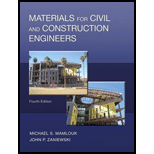
Pearson eText for Materials for Civil and Construction Engineers -- Instant Access (Pearson+)
4th Edition
ISBN: 9780137505586
Author: Michael Mamlouk, John Zaniewski
Publisher: PEARSON+
expand_more
expand_more
format_list_bulleted
Concept explainers
Question
Chapter 8, Problem 8.1QP
To determine
Write the definition of solid and hollow masonry units according to ASTM C90.
Expert Solution & Answer
Explanation of Solution
Solid masonry:
It is termed as a masonry unit whose net cross-sectional area
Hollow masonry:
The net cross-sectional area
Want to see more full solutions like this?
Subscribe now to access step-by-step solutions to millions of textbook problems written by subject matter experts!
Students have asked these similar questions
Which Material Directly applied in Masonry.
Explain how sampling and testing of masonry are done according to the ASTM standards.
One of the ASTM Designation for testing the quality of Masonry Units is ASTM C140. One of the purpose of this standard testing method is to test and determine the absorption of the Concrete hollow block. How do you conduct the testing and determine the absorption of CHB?
Chapter 8 Solutions
Pearson eText for Materials for Civil and Construction Engineers -- Instant Access (Pearson+)
Ch. 8 - Prob. 8.1QPCh. 8 - Prob. 8.2QPCh. 8 - Prob. 8.3QPCh. 8 - Prob. 8.4QPCh. 8 - Prob. 8.5QPCh. 8 - Prob. 8.6QPCh. 8 - Prob. 8.7QPCh. 8 - Prob. 8.8QPCh. 8 - Prob. 8.9QPCh. 8 - Prob. 8.10QP
Ch. 8 - Prob. 8.11QPCh. 8 - A portion of a medium-weight concrete masonry unit...Ch. 8 - A portion of a concrete masonry unit was tested...Ch. 8 - A concrete masonry unit was tested according to...Ch. 8 - Prob. 8.15QPCh. 8 - Prob. 8.16QPCh. 8 - A severe weathering clay brick was tested for...Ch. 8 - Prob. 8.18QPCh. 8 - What is the grout? What is the grout used for?Ch. 8 - Prob. 8.20QP
Knowledge Booster
Learn more about
Need a deep-dive on the concept behind this application? Look no further. Learn more about this topic, civil-engineering and related others by exploring similar questions and additional content below.Similar questions
- PART II: TEST ON HOLLOW BLOCK Question 6 One of the ASTM Designation for testing the quality of Masonry Units is ASTM C140. One of the purpose of this standard testing method is to test and determine the absorption of the Concrete hollow block. How do you conduct the testing and determine the absorption of CHB? Use the editor to format your answerarrow_forwardWrite three items that must be done during brick manufacturing to prevent their cracking.arrow_forwardRecognize the many types of concrete masonry units and be able to choose those suitable for various applications?arrow_forward
- Based on the data given, complete the required ASTM C140 calculations and compare them to the ASTM C90 requirements. Concrete masonry unit 8 × 8 × 16 in.arrow_forwardIdentify various clay masonry products and explain how they are typically used?arrow_forwardDefine Post-Tensioned Concrete.arrow_forward
- Identify and describe types of concrete-reinforcing materials.arrow_forwardA concrete masonry unit is tested for compressive strength and produces the following results: Failure load = 120 kips Gross area = 130 in 2 Gross volume = 960 in 3 Net volume = 447 in 3 a) is this unit categorized as solid or hollow? b) what is the compressive strength? c) does the compressive strength satisfy the ASTM requirements for load bearing units?arrow_forwardA portion of a normal-weight concrete masonry unit was tested for absorption and moisture content and produced the following masses: mass of unit as received = 1.95 kg saturated mass of unit = 2.13 kg oven-dry mass of unit = 1.91 kg immersed mass of unit = 0.95 kg Calculate the absorption in kg/m³ and the moisture content of the unit as a percent of total absorption. Does the absorption meet the ASTM C90 requirement for absorption?arrow_forward
- Define the optimal material for connecting fresh concrete to already cast concrete.arrow_forwardDiscuss the key tables of steel bar sizes and concrete mixturesarrow_forwardWhich of the following is true about hollow clay tile (terra cotta) masonry block? they can provide good fire resistance they can provide good acoustical separation they perform poorly in earthquakes all of the abovearrow_forward
arrow_back_ios
SEE MORE QUESTIONS
arrow_forward_ios
Recommended textbooks for you
 Construction Materials, Methods and Techniques (M...Civil EngineeringISBN:9781305086272Author:William P. Spence, Eva KultermannPublisher:Cengage Learning
Construction Materials, Methods and Techniques (M...Civil EngineeringISBN:9781305086272Author:William P. Spence, Eva KultermannPublisher:Cengage Learning

Construction Materials, Methods and Techniques (M...
Civil Engineering
ISBN:9781305086272
Author:William P. Spence, Eva Kultermann
Publisher:Cengage Learning